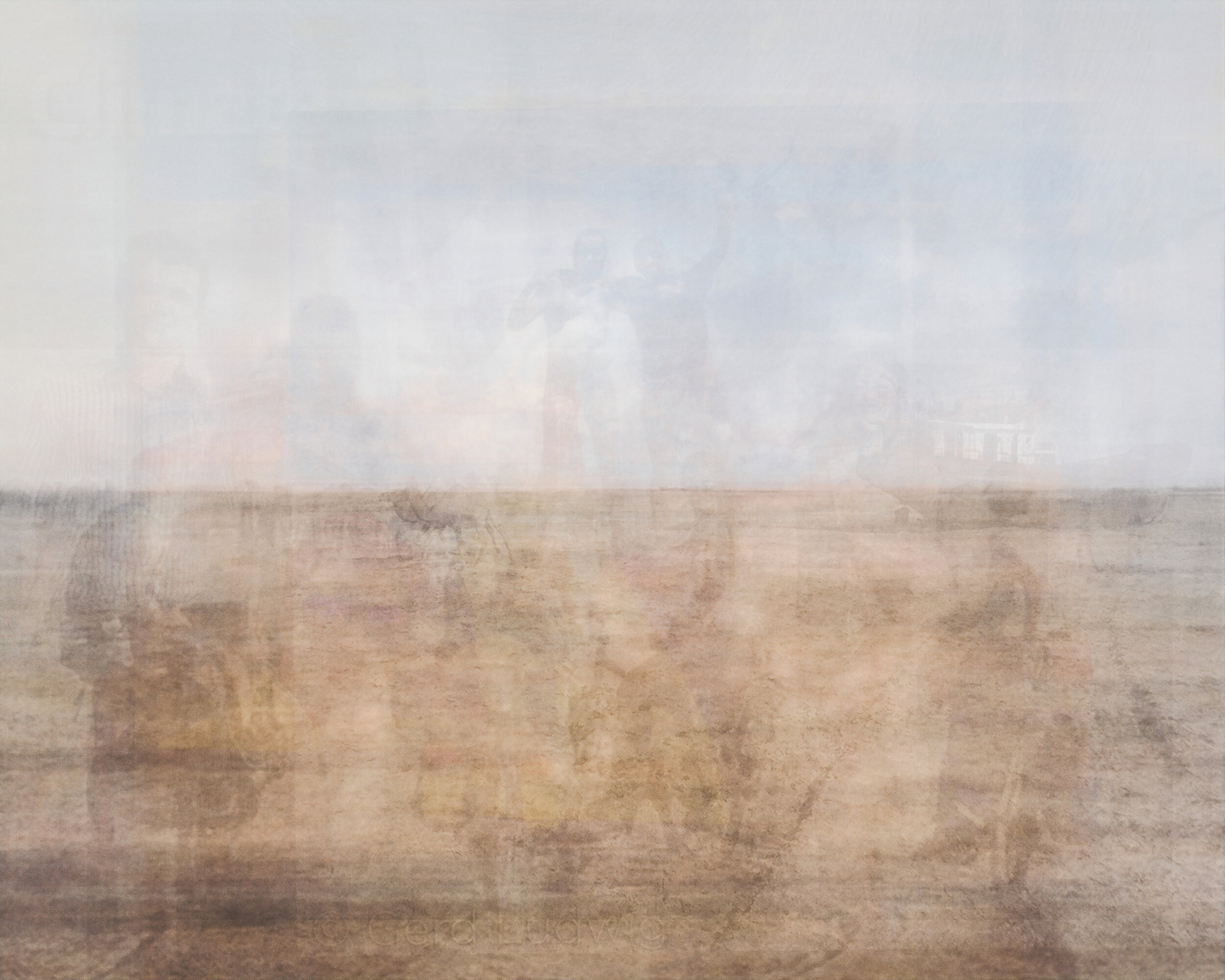Another Seascape
2019- (ongoing)
Another Seascape is a series following a previous series “It Is That It Is” (2017-), which aims to explore the unconscious and collective ontology suddenly appeared in the post Internet / the AI boom III.
In the previous series, the artist developed a system that collects whole images tagged with specific hashtags on Instagram and generate new images through letting AI analyse them clustering into several categories. The categories erratically contain phenomena that rarely can be seen in the daily life, so that they are not yet sociologically defined e.g. semi-nude women taking selfies in front of/on/in/by laundries, or stylish men taking selfies in front of urinals. They may have always existed, but they have suddenly emerged through the complicit collaboration of social media and artificial neural networks aka AI. Meaning that, the insignificant phenomena have become a blurred assemblage through the statistical computation.
In the new series, Tateisi proposes a statement about the appearance of the third seascape. There has been always the seascape in front of us as how we human/nonhuman see structurally. In the 18th century, we found the second seascape that metaphysically exists. In contemporary era, we admit both seascapes mentioned above, moreover, we’ve facing the third seascape that virtually exist through how digital nation share their seascapes collectively on social media such as hashtag.
The third seascape exists as a pure object. There is no division between sea and land in the object, nor the division between seascape and the observer. Time and space have lost their coordinates, that the present is no longer exists but only the past. The third seascape consists of human behaviour which most of the time appears as ghost, the blurred human outline, who supposed to be there standing in front of the lenses.
Each seascapes have their own institutions. They are alike the planet-chain that astronauts explore in Interstellar (2014). One of them let the ghosts stand with their backs, and gaze beyond the horizon (#foggysea, 2019). One of them let them walk across the horizon just like The Beatles (#arcticocean, 2019). One of them let them pose on a car with camels on the background where used to be sea (#aralsea, 2020).
Every institutions are based on the hashtags. Sometimes the hashtags are meant to be tagged differently from how they exist physically. How it spells matters delicately. #foggysea results unlike #foggyseas or #fogsea. There are numerous seascapes as much as the hashtags exist, and which still grows like the space does.
Another Seascape has been influenced by many of artists, art works and theories. For instance, what AI does with images collected from social media has referred contexts in found photo by artists such as Dick Jewell or Dona Meilach in 1960s-80s. A context of using images from Instagram in terms of the legal freedom led by Richard Prince in 2014 has been also referred. Despite, here are 4 main references that the series are lain on.
Another Seascape is a proposal statement with respect to Seascape (1980-present) by Hiroshi Sugimoto. The way Sugimoto design contexts and aesthetic have give Tateisi the quietness.
The ghosts watch and see how the world shifts alongside Antony Gormley’s sculptures. His attitude as an artist encourages Tateisi to be pure and believe in own-selves.
The series is produced relying on the dedicated method called Collective Idea for producing the works. Thomas Ruff says “you may have to develop your own technology to bring out the images”, that Ruff empowers Tateisi to expand the definition of contemporary photography.
A discourse around AI/neurography in art industry has escalated at the point of when a French art collective Obvious sold a work, which Generative Adversarial Network generated with an open-source model, for $432,500 in the beginning of 2018. Tateisi started producing AI art in late 2017, and has been challenging to question how artificial neural network affects human creativity.
《Another Seascape》は、2017年より展開されているシリーズ《It Is That It Is》に続く作品群であり、ポスト・インターネットおよび第三次AIブーム以降に突如顕在化した無意識的かつ集合的な存在論を探究する試みである。
《It Is That It Is》では、Instagram上の特定ハッシュタグが付された全画像を収集し、AIによる分析とクラスタリングを通じて新たな画像を生成するシステムが構築された。そこに出現するカテゴリーには、日常的には稀にしか見られず、社会学的にまだ定義されていないような現象が含まれている。例えば、コインランドリーの前や中で自撮りをする半裸の女性たち、または小便器の前で自撮りをするスタイリッシュな男性たちである。こうした現象はかねてより存在していた可能性があるが、ソーシャルメディアと人工ニューラルネットワーク、すなわちAIとの共犯的関係のもとで、統計的処理によって曖昧な集合体として突如現前化した。
この新たなシリーズにおいて立石は、「第三の海景」の出現に関するステートメントを提示する。人間/非人間に共通する構造的な視覚として、海景は常に目の前に広がってきた。18世紀には、それとは異なる「形而上的な第二の海景」が見出される。そして現代においては、これら二つの海景を前提としながら、さらに「第三の海景」が現れつつある。それは、デジタル国家がハッシュタグなどを通じてソーシャルメディア上で共有する集合的な視覚のネットワークによって、仮想的に立ち現れる海景である。
第三の海景は、純粋なオブジェクトとして存在している。その中には、海と陸の境界も、海景と観察者との境界も存在しない。時間と空間は座標を失い、現在はもはや存在せず、あるのは過去のみである。この第三の海景は、人間の行動によって構成されるが、その姿は多くの場合「幽霊」として現れる。すなわち、レンズの前に立っていたはずの、ぼやけた人影としてである。
それぞれの海景には独自の制度(インスティテューション)が存在する。それらはまるで映画『インターステラー』(2014)における惑星連鎖のようである。ある制度では、人々が背を向けて地平線を見つめる (#foggysea, 2019)。ある制度では、彼らがビートルズのように地平線を横切る (#arcticocean, 2019)。また別の制度では、かつて海だった場所に立つラクダを背景に車の上でポーズをとる (#aralsea, 2020)。
これらの制度は、すべてハッシュタグを基盤としている。ハッシュタグは、物理的な実態と異なる形で用いられることもあり、その綴り方が意味を大きく左右する。たとえば #foggysea と #foggyseas、#fogsea は異なる結果をもたらす。ハッシュタグの数だけ海景が存在し、それは宇宙のように増殖し続けている。
《Another Seascape》は、多くの芸術作品や理論に影響を受けている。たとえば、ソーシャルメディアから収集された画像にAIが行う操作は、1960〜80年代におけるDick JewellやDona Meilachといった作家による「ファウンド・フォト」の文脈に接続される。また、Instagram画像の使用と法的自由に関する文脈では、2014年にRichard Princeが行った実践も参照されている。
とりわけ本シリーズにおいて中核をなす4つの参照項は以下の通りである。
第一に、《Another Seascape》は、杉本博司による《海景》(1980–)に対する提案的ステートメントとして構想されている。杉本による文脈と美学の設計は、立石に静寂の感覚を与えた。
第二に、ゴーストたちはAntony Gormleyの彫刻作品と共に世界の変容を見守る。Gormleyの芸術家としての姿勢は、立石に「純粋であること」や「自己を信じること」の重要性を示唆している。
第三に、本シリーズは「集合的なアイデア(Collective Idea)」と呼ばれる方法論に基づいて制作されている。Thomas Ruffの「イメージを引き出すためには自らの技術を開発しなければならない」という言葉は、立石に現代写真の定義を拡張する力を与えた。
第四に、AI/ニューログラフィに関する芸術業界での議論は、2018年初頭、フランスのアート・コレクティブ「Obvious」がオープンソースのモデルを用いてGAN(敵対的生成ネットワーク)で制作した作品を43万2500ドルで販売したことを契機に高まりを見せた。立石は2017年後半よりAIアートの制作を開始し、人工ニューラルネットワークが人間の創造性に与える影響を問い続けている。



